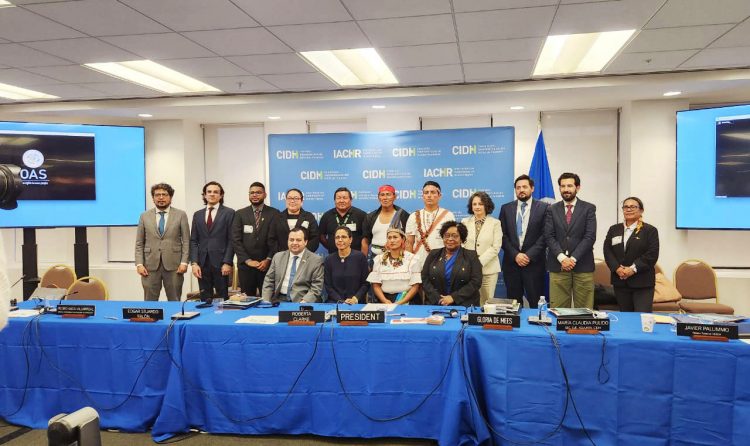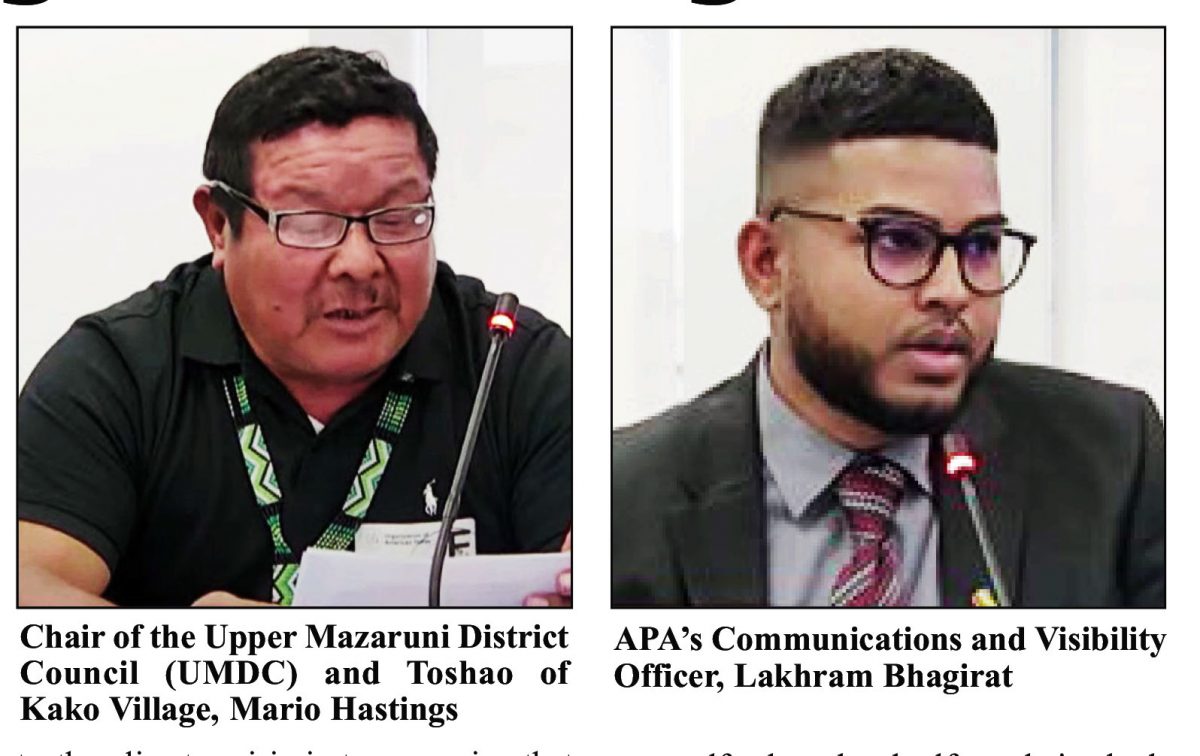The Amerindian Peoples Association (APA) continue to express their disagreement with the government’s handling of the carbon credit process with their participation in a thematic hearing on ‘the impact of carbon market expansion on Indigenous Peoples and local communities in Colombia, Guyana, Peru and Brazil’ during the 189th session of the Inter-American Commission on Human Rights (IACHR) in Washington, DC, USA.
A release on Saturday from the APA informed that their presentation at the hearing was delivered by its Communica-tions and Visibility Officer, Lakhram Bhagirat, and focussed on the technical shortcomings in the Guyana carbon scheme process. It explained that Bhagirat chronicled the association’s experience with the Architecture for REDD+ Transactions (ART) grievance mechanism. IACHR heard that APA made a complaint to ART in March 2023, but ART did not address the substance of its complaint, which was that ART certified credits to Guyana despite violations of Indigenous Peoples’ rights and the lack of effective consultations with Indigenous peoples as the owners of the lands and forests.

Chair of the Upper Mazaruni District Council (UMDC) and Toshao of Kako Village, Mario Hastings who was also part of the Guyana delegation to the Commis-sion, delivered the community’s experiences with the carbon scheme. He pointed out that while the government publicly claims that it held consultations with the Indigenous communities on the carbon credits, those meetings were not consultations which meant the Indigenous Peoples’ were deprived of free, prior and informed consent (FPIC).
“Our people still have many questions and concerns about carbon credits and markets and what they mean for our lands, our livelihoods, our cultures, and our rights. The government says that Indi-genous peoples agreed to their plan to sell carbon credits because the National Toshaos Council endorsed the plan.”
The village leader added that “the NTC has advisory functions only. I am a member of the NTC Executive Committee. The Government tries to say that the NTC is the only legitimate representative of Indigenous peoples, but that is not true. We have the right to decide how we want to make our collective decisions and we have the right to choose our own representatives. The NTC has not been chosen by our villages to represent them and make decisions on their behalf on this matter.”
Toshao Hastings told the IACHR that the NTC was presented with a resolution to endorse the government’s carbon programme, but leaders did not have an opportunity to understand, discuss and take it back to their communities for further deliberation.
“It is wrong to say that all Indigenous leaders in Guyana agreed to selling carbon from all of our forests, or even that all Indigenous leaders participated in the decision.”
The Akawaio Leader related that while the Government of Guyana is claiming that Indigenous peoples are enjoying the benefit-sharing under the carbon credits scheme, the fact of the matter is that the communities were not given the opportunity to help design the benefit-sharing plan and tell the government what they considered as appropriate compensation for having all their forests included in the national carbon scheme.
“Indigenous peoples should be the ones to tell the government what we consider the appropriate compensation and benefits from having all of our forests included in the national carbon credit programme, not the other way around. This is a part of our right to self-determination,” argued Toshao Hastings, in his presentation to the Commissioners.
He also spoke of the government’s highhandedness in formulating the benefit-sharing plan.
“In Guyana’s case, our villages were put in a position where our only options were to take the government’s benefit-sharing plan or get nothing at all for the carbon from our own lands. Our acceptance of those limited benefits is now being used by the Government to say we gave our FPIC to be part of the programme from the outset… even if some people are happy to receive some money from the carbon credits sale, we still don’t know what the risks are for us.”
As such, he suggested to the IACHR that the ideal way for Indigenous peoples to access finance from a carbon market, if they choose to do so, would have been for their villages to have time, through internal processes, to discuss their plans and visions for life, and the protection of their territories. He noted that however, this did not happen in Guyana, where the “so-called solution” was “designed” by the government and to date Indigenous Peoples have not even been presented with sufficient information about what it entails.
Toshao Hastings also criticized the usefulness of carbon credits. “We have not seen any proof that selling carbon is helping Mother Earth. Even though the government is selling carbon credits and promising to keep the trees standing, the government continues to give out mining concessions without caring about the destruction of our forests…our rights have not been respected and protected in this carbon credits process. The true solution to the climate crisis is to recognize that indigenous peoples are the owners and stewards of our lands and forests.”
Meanwhile, in recounting the APA’s experience with ART’s grievance mechanism, Bhagirat said that following the dismissal of APA’s initial complaint in May 2023, an appeal was filed and again the process was stacked against the organisation. He told the IACHR that ART asked the APA to sign terms of reference for the appeal that would have made it all but impossible to expect a fair outcome, and ART refused suggestions based on international standards for grievance mechanisms to improve the process. Further, ART even claimed that the standards for grievance mechanisms do not apply to it.
“The case that we have presented serves as a warning that must inform global efforts to move away from the destruction of our nature and climate and towards just and sustainable societies. It shows that one of the leading jurisdictional REDD+ certification schemes – one that promotes itself as a model for high integrity, by aligning with the UNFCCC Cancun Safeguards and international human rights law – has facilitated the sale of carbon credits which are generated in violation of the rights of Indigenous peoples,” Bhagirat noted.
He added “The world should learn as an important lesson from this case that private, self-selected and self-regulating bodies such as ART cannot be left to enforce compliance with a standard that speaks about human rights without sufficient expertise or oversight to ensure that those human rights are respected in practice. To do otherwise – to recognize Indigenous peoples’ rights in word but not in practice – is to render meaningless the very rights these bodies claim to uphold.”
According to the release, the APA’s presentation was done in conjunction with the Federation of Indigenous Kechwa Cha-zuta Amazonian Peoples (FEPIKECHA); the Ethnic Council of the Kichwa Peoples of the Amazon (CEPKA); the Federation of Indigenous Kechwa Peoples of Bajo Huallaga San Martin (FEPIKBHSAM); the Coordinating Committee for the Development and Defense of Indigenous Peoples of the San Martin region (CODEPISAM) and the Institute for Legal Defense (IDL) of Peru; the Indigenous Government of Pirá Paraná; Gaia Amazonas and the Center for the Study of Law, Justice and Society (Dejusticia) of Colombia; the Coordination of the Associations of the Remnant Communities of Quilombos de Pará (MALUNGU) and the Socio-environmental Institute (ISA) of Brazil; and the regional organizations Forest Peoples Programme (FPP) and the Due Process of Law Foundation (DPLF).





